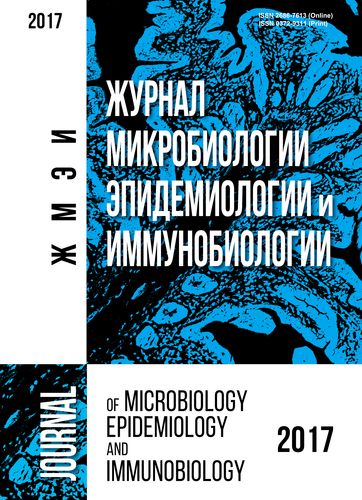ВЛИЯНИЕ ТОКСИНОВ YERSINIA PSEUDOTUBERCULOSIS НА ФОРМИРОВАНИЕ БИОПЛЕНКИ
- Авторы: Терентьева Н.А.1, Псарева Е.К.2, Тимченко Н.Ф.2, Голотин В.A.1, Рассказов В.А.1
-
Учреждения:
- Тихоокеанский институт биоорганической химии им. Г.Б.Елякова
- НИИ эпидемиологии и микробиологии им. Г.П.Сомова
- Выпуск: Том 94, № 6 (2017)
- Страницы: 37-42
- Раздел: Статьи
- URL: https://microbiol.crie.ru/jour/article/view/228
- DOI: https://doi.org/10.36233/0372-9311-2017-6-37-42
- ID: 228
Цитировать
Полный текст
Аннотация
Об авторах
Н. А. Терентьева
Тихоокеанский институт биоорганической химии им. Г.Б.Елякова
Автор, ответственный за переписку.
Email: noemail@neicon.ru
Россия
Е. К. Псарева
НИИ эпидемиологии и микробиологии им. Г.П.Сомова
Email: noemail@neicon.ru
Россия
Н. Ф. Тимченко
НИИ эпидемиологии и микробиологии им. Г.П.Сомова
Email: noemail@neicon.ru
Россия
В. A. Голотин
Тихоокеанский институт биоорганической химии им. Г.Б.Елякова
Email: noemail@neicon.ru
Россия
В. А. Рассказов
Тихоокеанский институт биоорганической химии им. Г.Б.Елякова
Email: noemail@neicon.ru
Россия
Список литературы
- Видяева Н.А., Ерошенко Г.А., Шавина Н.Ю., Кузнецов О.С., Кутырев В.В. Изучение способности к образованию биопленок у штаммов Y. pestis основного и неосновного подвидов. Журн. микробиол. 2009, 5: 13-19.
- Псарева Е.К., Собянин К.А., Ермолаева С.А., Тимченко Н.Ф. Молекулярно-генетическая характеристика цитотоксического некротизирующего фактора Yersinia pseudotuberculosis. Российский иммунологический журнал. 2015, 9 (2): 602-603.
- Романова Ю.М., Гинпбург АЛ. Бактериальные биопленки как естественная форма существования бактерий в окружающей среде и организме хозяина. Журн. микробиол. 2011, 33: 99-109.
- Терентьева Н.А., Тимченко Н.Ф., Балабанова JLА., Рассказов В.А. Характеристика образования, ингибирования и разрушения биопленок Yersinia pseudotuberculosis, формирующихся на абиотических поверхностях. Журн. микробиол. 2015, 3: 72-78.
- Терентьева, Н.А. Тимченко Н.Ф., Голотин В.А., Рассказов В.А. Биологическая активность токсинов Yersinia pseudotuberculosis. Журн. микробиол. 2016, 6: 10-19.
- ТимченкоН.Ф., Недашковская Е.П., Долматова JI.С., Сомова-ИсачковаЛ.М. Токсины Yersinia pseudotuberculosis. Владивосток, 2004.
- Comelis G.R. Yersinia type III secretion: send in the effectors. J. Cell. Biology. 2002, 158 (3): 401-408
- Costerton J.W., Stewart P.S., Greenberg E.P. Bacterial biofilms:a common cause of persistent infections. Science. 1999, 284: 1318-1322.
- Flemming H.C. EPS - then and now. Microorganisms. 2016, (4): 4. pii: E41 PMID: 27869702.
- Herrera A., Vu B.G., Stach C.S. et al. Staphylococcus aureus (i-toxin mutants are defective in biofilm ligase and sphingomyelinase activity, and causation of infective endocarditis and sepsis. Biochemistry. 2016, 55 (17): 2510-2517. doi: 10.1021/acs.biochem.6b00083.
- Huseby M.J., Kruse A. C., Digre J. et al. Beta toxin catalyzes formation of nucleoprotein matrix in staphylococcal biofilms. Proc. Natl. Acad. Sci. USA. 2010, 107: 14407-14412.
- Lister J.L., Horswill A.R. Staphylococcus aureus biofilms: recent developments in biofilm dispersal. Front. Cell. Infect. Microbiol. 2014, 4: 178.
- Schweer J., Kulkami D., Kochut A. et al. The cytotoxic necrotizing factor of Yersinia pseudo-tuberculosis (CNFY) enhances inflammation and Yop delivery during infection by activation ofRho GTPases. PLoS Pathog. 2013, 9 (11): el003746. doi: 10.1371/journal.ppat. 1003746.
- Shak J.R., Ludewick H.P., Howery K.E. et al. Novel role for the Streptococcus pneumoniae toxin pneumolysin in the assembly of biofilms. MBio. 2013, 4 (5): e00655-13. doi: 10.1128/ mBio.00655-13.
- Wen Y., Behiels E., Devreese B. Toxin-Antitoxin systems: their role in persistence, biofilm formation, and pathogenicity. Pathog. Dis. 2014, 70 (3): 240-249. doi: 10.1111 /2049-632X. 12145.
Дополнительные файлы






